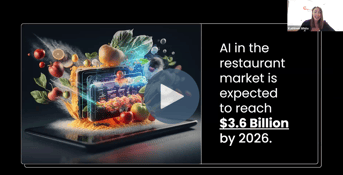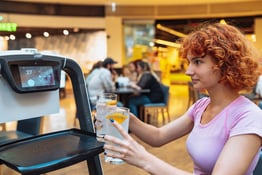Alcohol sales fell sharply in 2024, and while liquor wholesalers are pointing to inflation, the fact is that an increasing number of Americans see drinking as unhealthy. Younger people (especially Gen Z) have been leading the charge, so this trend might be here to stay.
For restaurant owners who aren’t yet fully immersed in the sober revolution — or who simply don’t have a liquor license — now is the time to develop a thoughtful non-alcoholic drinks menu that can boost your restaurant’s sales through Dry January and well into the future.
What Do the Non-Alcoholic Options Look Like for Dry January?
In recent years, a new industry of non-alcoholic spirits, wines, and beers has risen that enables bartenders to recreate the classics in zero-proof form — or to develop entirely new concoctions.
“We try to carry drinks that appeal to a range of non-drinkers,” said Bandy Bowman, acquisitions and product training manager for Boisson, a New York City-based non-alcoholic beverage retailer. Non-drinkers include a range “from ‘sober-sober’ to ‘sober-curious,’ as well as those with religious beliefs that prohibit the use of alcohol and to people abstaining for health reasons.”
So, what might this look like at your restaurant?
For a truly well-rounded non-alcoholic restaurant drink menu, consider incorporating options that mirror your alcoholic offerings: wines, beers, ciders, spirits, and cocktails. Your alcohol-free beverages should scratch the same itch that their alcoholic counterparts do. They can pop with just as much flavor and complexity of colors, smells, and tastes as alcoholic drinks.
“Alcohol-free wines are our top sellers,” Bowman said. “Folks are really looking to maintain the ritual around wine-drinking, especially with food. I seek products that fill that need, and not just as a wine alternative, but as a real glass of wine, with flavor and complexity, and ability to pair with food.”
How to Build a Non-Alcoholic Bar Inventory
With the way the zero-proof market has exploded, you’ve got a lot of options — meaning there’s something available to suit every taste
Zero-proof spirits can be divided into two categories: those that seek to replicate the experience of a particular alcoholic staple — non-alcoholic gin, non-alcoholic whiskey, even non-alcoholic tequila — and those that shine as entirely new creations. No matter why someone isn’t drinking, every patron can enjoy a beverage that is both sophisticated and complex — sometimes with a zing.
“Across all of our locations, the cocktail programs are characterized by a more whimsical approach to flavor and presentation, and that definitely extends to our zero-proof offerings,” said Brian Evans, beverage director at New York-based Sunday Hospitality (which includes the storied Chelsea Hotel).
Whether Dry January or a warm summer day, Evans said that having creative non-alcoholic beverage options is a great way to let your patrons know that you also have something for them when they are choosing not to drink alcohol.
“At the Hotel Chelsea Lobby Bar, we have a spirit-free cocktail that’s actually the most prep-intensive cocktail on the entire menu,” Evans said. “We start with an NA aperitivo and infuse it with cacao butter, and we add a strawberry spirit and a house-carbonated lemon verbena sparkling ‘wine,’ so it has a lot of layers to it. When people drink it, they’re pretty smitten by it.”
Creating a Lucrative Non-Alcoholic Beverage Program for Your Restaurant
Many early adopters of the NA movement are restaurants that have a serious beverage program.
“A lot of restaurants put a lot of thought into their food, and then they just kind of run out of steam when it comes to the beverages,” Bowman said. “The restaurants that end up partnering with us tend to be the ones who are already putting a lot of care into their cocktails, having a great wine program, that kind of thing. These are the folks that realize it’s a great revenue opportunity as well as a way to be inclusive.”
You don’t have to be a high-end cocktail bar or run your own wine club to take an interest in elevating this style of drink.
Here are five ways to build out a successful non-alcoholic cocktail menu — for Dry January and beyond.
#1: Offer a Variety of Options
First and most importantly, don’t just tack a single non-alcoholic option onto your menu and call it a day. Variety is the spice of life, and everything from the season to the stage of the meal can affect a drink order — so give your customers enough options to suit a broad spectrum of tastes and needs.
#2: Don’t Assume the Same Rules Apply
Zero-proof cocktails aren’t as simple as a straight swap of NA spirits for alcoholic ones. Mixing drinks is an art as well as a science, and you’re going to need to do some experimentation to find the right interplay of tastes, smells, and mouthfeel with your new drink bases.
“When implementing a non-alcoholic spirit into a cocktail build, you definitely have to rejigger your ratios for the perception of sour, sweet, and body,” Evans said. “An experienced bartender making a sour cocktail will instinctively want to do three-quarter ounce of lemon or lime juice, three-quarter ounce simple syrup. With a non-alcoholic cocktail, I would dial down the citrus by a quarter ounce, because the lack of body from the NA spirit heightens the citrus flavor, and you end up with something really tart.”
#3: Get Creative With It
It’s almost always all about how you sell it. Good names and interesting presentations will make your new drinks look fun and intriguing — so put the same creativity into them that you do into everything else. Keep in mind that since non-alcoholic drinks are particularly appealing for younger customers, they should have a place in your social media strategy. And as with all menu items, your bartenders and servers should be knowledgeable about all the ingredients in your NA libations to ensure that everyone has a positive experience.
#4: Use What Your Bar Already Has
While the alchemy of creating a non-alcoholic drink for your cocktail list might differ from that of a traditional cocktail, most bartenders already have the tools they need on hand.
“You’re already prepping your syrups and mixers for your alcoholic cocktails,” Evans said. “There’s no reason you can’t incorporate those into your non-alcoholic offerings as well.”
Evans has also found that people will come in and will request non-alcoholic drinks not knowing they are on the menu. When you take the time to be thoughtful about how your non-alcoholic beverage menu integrates with what you are already doing at your restaurant or bar, customers appreciate it.
“When we tell them that we have a zero-proof cocktail menu, they’re usually taken aback to find that we’ve put so much energy into that,” Evans said. “They’re grateful for it, so they go for it.”
#5: Find the Right Price for Your Patrons
Your market will likely dictate what you can charge. In big cities like New York and Chicago, where $20 cocktails aren’t unusual and there’s a relatively well-developed market for tee-totaling options, a $15 non-alcoholic beverage may not be controversial.
“If you can charge $15 for a cocktail with no alcohol in it to a person who would have otherwise gotten a free glass of water, why wouldn’t you?” Bowman said. “It’s a win-win, really. You turn a profit, and your guest gets to feel like they’re enjoying the whole experience.”
At a more low-key establishment in a smaller market, however, your customers might scoff at a double-digit price tag for a drink without any alcohol. Since this is a relatively new menu category, you may want to offer drinks at a range of price points — giving people the opportunity to get acquainted with your NA options without over-committing.
Is Dry January Here To Stay? Maybe.
As you spin up a new drink list for Dry January and beyond, it’s good to stay on top of trends — both in terms of ingredients and menu verbiage. It’s now best practice to refer to your non-alcoholic choices as “zero-proof” or simply “NA” as opposed to calling them “mocktails.”
But whatever you call them, these sophisticated new elixirs are not only here to ring in the new year, but to accommodate the changing tastes of your customers for the long haul.
Curious about how a non-alcoholic beverage menu will impact your inventory management needs? Book a free Discovery Call with a Back of House expert to find the right technology solution for your needs.
Additional reporting by Lexie Kelly Wainwright.
[Photo by Ralph (Ravi) Kayden on Unsplash]





